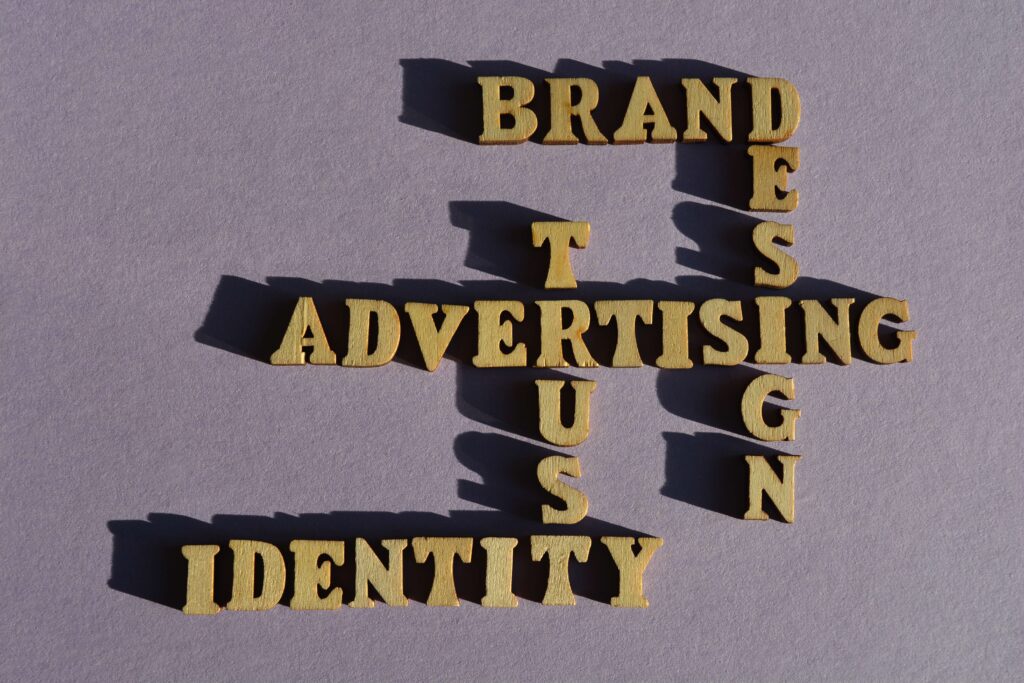A strong brand identity is not just a nice-to-have; it’s the lifeblood of any business, big or small. But what exactly do we mean by ‘brand identity’? It’s the unique sauce of visuals, messaging, and experience that sets your company apart from the crowd. Think of it as the face and personality of your business: the logo, the colours you use, the fonts on your website, and even the tone of your emails—all these elements come together to tell your story.
For businesses grappling with the digital age’s relentless pace, a well-crafted brand identity is a beacon that guides customers to their shores. It’s how customers recognise you in a sea of competitors and start to build an emotional connection with your business. Whether you’re a one-person show operating from a kitchen table or a multinational corporation, your brand identity is your signature—distinct, recognisable, and imbued with your values.

But why is brand identity so crucial, you ask? It’s simple: in a world where consumers are bombarded with choices, your brand identity helps you stand out. It’s not just about looking good (though that’s certainly part of it); it’s about conveying your business’s ethos, promise, and the experience customers can expect. When done right, it can turn a first-time buyer into a lifelong customer.
The Necessity of Brand Identity for Different Business Sizes
Brand identity isn’t a luxury reserved for the heavyweights in business; it’s a fundamental necessity for all, from fledgeling startups to established conglomerates. Let’s break down why businesses across the spectrum need to pay attention to their brand identity.
Startups and Small Businesses: Making Your Mark
For startups and small businesses, a strong brand identity is the slingshot that can help you compete with Goliaths in your industry. It’s about making an indelible mark quickly and effectively. A distinctive brand identity not only captures attention but also encapsulates your vision and values right from the off. It’s your first impression, your chance to tell a compelling story that resonates with your audience and sticks in their memory. In the early stages, when you’re hustling for every bit of recognition, a coherent brand identity can be the difference between being noticed and being overlooked.
Medium-Sized Businesses: Carving Out Your Niche
As businesses grow, the need for a clear brand identity becomes more pronounced. For medium-sized businesses, it’s a strategic tool to carve out a niche in a crowded marketplace. Your brand identity should evolve to reflect the growing sophistication of your business operations and customer base. It’s about reinforcing your position in the market, distinguishing your offerings, and ensuring that customers think of you first. A well-defined brand identity at this stage helps to solidify the loyalty of your existing customers while attracting new ones by showcasing your professional maturity and stability.
Large Enterprises: Staying Relevant and Influential
For the big players, brand identity is about staying relevant in a rapidly changing world. It’s not just about maintaining a legacy; it’s about leading the charge and setting the pace for innovation. A robust brand identity for large enterprises supports their authority and thought leadership. It helps them navigate market shifts, mergers, acquisitions, and the global scaling of products and services. With a strong brand, large businesses can maintain a cohesive presence across diverse markets and product lines, ensuring that their message remains consistent and powerful no matter where they operate.

Brand Identity and Consumer Perception
The power of brand identity extends far beyond a mere logo or colour palette; it fundamentally shapes how consumers perceive and interact with a business. A thoughtfully designed brand identity can speak volumes about what your business stands for and can influence consumer decisions in profound ways.
Crafting Consumer Expectations
When consumers encounter your brand, they’re not just looking at a product or service; they’re assessing a promise. Your brand identity sets the stage for their expectations. It’s the shorthand for what they can anticipate when making a purchase or engaging with your service. A polished, professional brand look can instil confidence, suggesting quality and reliability, while a quirky, bold identity might convey innovation and fun.
The Psychological Impact on Behaviour
The colours, shapes, and fonts in your brand identity are not arbitrary choices—they’re strategic decisions that play to human psychology. For instance, blue can evoke trust and dependability, making it a favourite for financial institutions, while green often represents health and sustainability, a go-to for organic brands. The right combination can make your brand not just seen but felt, influencing consumer behaviour and driving engagement.
Real-Life Transformations and Their Effects
Take, for example, the transformation of Burberry. Once a classic British brand associated with outdoor attire, it faced challenges in the early 2000s due to its ubiquitous check pattern becoming synonymous with anti-social behaviour in the UK. The brand’s identity was in crisis, and it needed a drastic overhaul to change consumer perception.
Burberry’s response was a masterclass in brand revitalisation. By appointing a new creative director, Christopher Bailey, the company began to shed its tarnished image. Bailey steered the brand towards the high-fashion echelons with innovative designs and quality craftsmanship, while still honouring its heritage. The iconic check pattern was used more judiciously, and a new range of products was introduced to appeal to the luxury market.
The rebranding efforts extended to their advertising campaigns, which featured British celebrities and models, reinforcing the brand’s high-end British legacy. Burberry also embraced digital innovation, becoming one of the first luxury brands to stream its fashion shows online, thus engaging a broader audience.
The result was a remarkable turnaround in consumer perception. Burberry re-established itself as a luxury fashion house and regained its status as a symbol of British style and elegance. Sales soared, and Burberry became a coveted brand, shaking off its negative associations and attracting a new generation of consumers.
This transformation shows how a strategic rebrand can revitalise consumer perception, demonstrating that brand identity is much more than skin deep—it’s the essence of what a company represents to its customers.
The Impact of Brand Identity on Business Performance
A robust brand identity does more than just distinguish a business from its competitors; it can significantly influence its bottom line. Here’s how a strong brand identity can translate into improved business performance.

Driving Marketing and Advertising Effectiveness
Marketing campaigns are the spearhead of a business’s growth strategy, and a strong brand identity amplifies their impact. When consumers can easily recognise and align with a brand’s identity, marketing messages resonate more deeply. This recognition can lead to more effective and efficient advertising, as campaigns build on the established presence of the brand rather than starting from scratch to gain consumer attention.
Enhancing Customer Loyalty and Retention
A consistent brand identity across all touchpoints helps cement customer loyalty. When customers have a clear understanding of what a brand stands for, they’re more likely to form an emotional connection with it. This connection fosters loyalty, which is crucial for repeat business—a key driver of revenue. It’s far more cost-effective to retain existing customers than to acquire new ones, and a strong brand identity is at the heart of customer retention strategies.
Facilitating New Product Acceptance
When a business with a well-established brand identity launches a new product, the existing brand equity can help reduce the market’s resistance to adoption. Customers already trust the brand and are more open to trying new offerings under its umbrella. This trust can shorten the sales cycle for new products and services, giving businesses a competitive edge in the market.
Attracting Talent and Building Culture
A strong brand identity doesn’t just affect external perceptions; it also plays a significant role internally. Companies with a clear identity attract employees who identify with the brand’s values and culture. This alignment can lead to a more engaged and motivated workforce, driving productivity and innovation. Moreover, employees become brand ambassadors outside the company, extending the brand’s reach and reputation.
Conclusion
In conclusion, a brand identity is far from a static visual emblem; it’s a dynamic and pivotal asset that drives business growth. It informs marketing strategies, underpins customer relationships, accelerates product launches, and attracts top talent. In the final analysis, a well-conceived brand identity is not just a facet of your business’s aesthetic appeal—it’s a foundational component of its strategic development and market success.




